“Swalty” (a portmanteau of “sweet” and “salty”) is having a moment, and we — along with anyone lacking a sweet tooth — couldn’t be happier. While there’s nothing wrong with foods that are inherently sweet, there is something magical when that cloyingly sweet flavor is matched with a salty complement. The reason swalty tastes so good boils down to science. The human body craves both sugar (for caloric density and pleasure) and salt (for meeting mineral needs), and when paired together, the flavors magnify one another. This concept, called “flavor layering,” can also suppress other flavors, like bitter, leading to more well-rounded and better-tasting food.
You may have shamelessly shoved fries into your Wendy’s Frosty before, but thinking about how to incorporate swalty more often into your culinary routine may prove a bit more difficult. To get some insight on the best sweet foods that taste better with a pinch of salt, we consulted the experts: Joanne Gallagher, recipe developer at Inspired Taste; Olivia Roszkowski, chef-instructor of health-centered culinary arts at the Institute of Culinary Education’s New York City campus; and Audrey Santos, sous chef at Maricel’s Kitchen. They shared not only their best swalty combinations, but also how to use salt and other similarly flavored ingredients to achieve masterful flavor layering at home.
Read more: Here’s Why Popcorn Tastes So Much Better At The Movie Theater
Caramel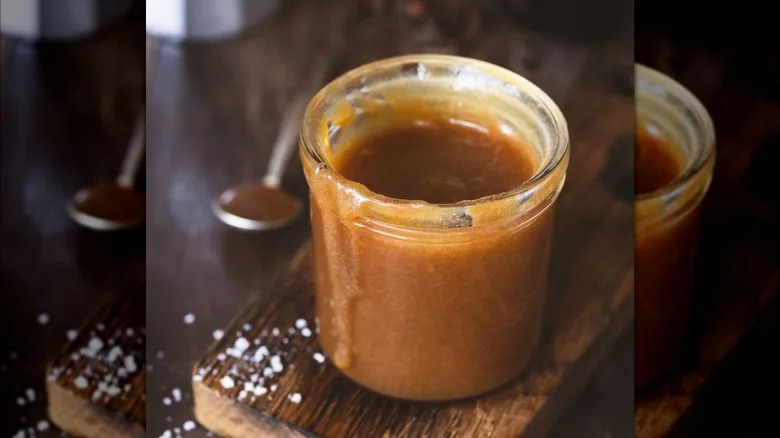
Jar of caramel with salt – Arx0nt/Getty Images
Nowadays, it seems like you can’t find caramel without “salted” being attached to it. Salted caramel candies, ice cream sauces, ice creams, and more have populated the dessert scene — for good reason. Caramel, which in its most basic form is cooked sugar (and often cream, in the case of candies), tends to have one flavor note: sweet. It can be a very overwhelming ingredient because of this profile, making it the perfect place for salt to weasel its way in. In addition, Olivia Roszkowski, chef-instructor of health-centered culinary arts at the Institute of Culinary Education, explains that salt can also temper the bitter flavors created during the caramelization process. “Adding a pinch of salt to the finished confection creates a burst of sweetness that emphasizes the natural buttery and sweet nutty flavors,” she says.
Joanne Gallagher, recipe developer at Inspired Taste, recommends adding flaky or coarse sea salt to caramel, saying it “lets its crunch and flavor pop.” It can also offer a unique visual contrast against the torrent of caramel sauce on something like a cookie, brownie, or scoop of ice cream.
Besides just adding a sprinkle of salt to your caramel, you can also play with salty ingredients in the caramel itself. One of my favorites to experiment with is miso, which offers an umami and savory edge, not just a salty one. A miso caramel sauce is particularly decadent in brownies or drizzled on ice cream.
Brownies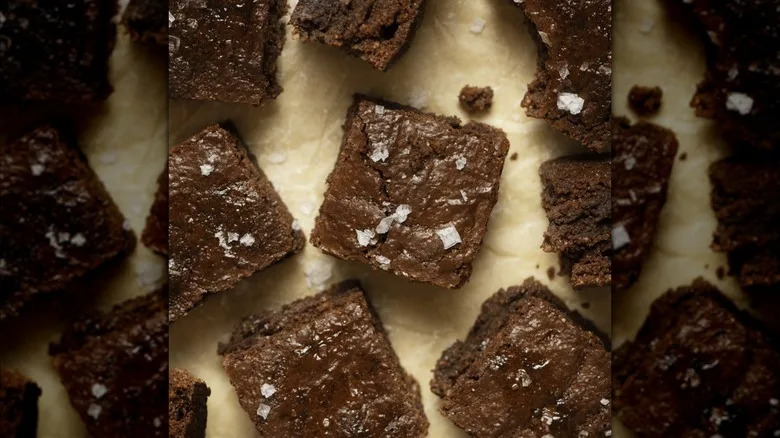
Brownies with sea salt on parchment – Monica Bertolazzi/Getty Images
Brownies are known for their chocolatiness and decadence, so much so that it’s easy to get lost in them. Salt can help balance their heavy flavor and draw attention to the primary ingredient: chocolate. “In rich desserts like these, salt contrasts with the sweetness, intensifies chocolate notes, and helps to mellow out the bitterness,” says Joanne Gallagher. Like caramel, she recommends adding a sprinkle of coarse or flaky salt after baking, which she says “brings a burst of salty crunch without overwhelming the dessert.” You could even try sprinkling the pan with salt before pouring in your brownie mixture. That way, when you bite into the brownie, the first thing on your taste buds will be the salt.
Besides using regular salt, you may also want to play with an array of brownie mix-ins that have salty elements. Even if you’re working with a boxed brownie mix, you may want to add jarred salted caramel sauce, salty pretzels, or a garnish of chocolate-covered potato chips to lend some salt, as well as complementary flavors and textures. You may also want to add a pinch of salt to the batter itself, as this can balance the sweetness and chocolatey undertones of the batter. Soy sauce, miso, and other salty, savory add-ins will also lend your recipe flavor and funk.
Chocolate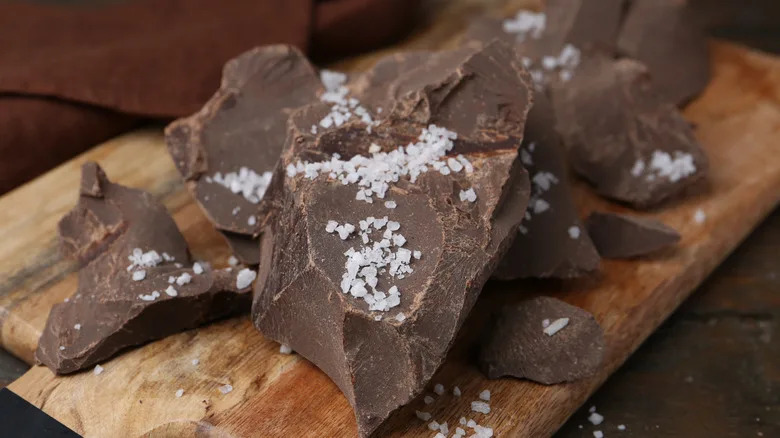
Pieces of chocolate with salt – Olga Yastremska/Getty Images
Salt has infiltrated the chocolate market. It’s not uncommon to see salted dark chocolate bars, salt-covered chocolate candies, and other salty chocolate treats in confectioner’s shops and grocery stores. And, chocoaltiers may be on to something here. This sweet isn’t just sugary; it also has some bitter and sharp undercurrents as well. “The cocoa solids present in chocolate are naturally bitter, and so the addition of salt helps suppress that inherent taste, while bringing forward the sweet and fruity undertones in the chocolate,” says Olivia Roszkowski. She explains that this is why salt is best suited for dark chocolate confections, like this dark chocolate-covered salted caramels recipe, as white and milk chocolates tend to be less bitter.
The type of salty ingredient you should add to chocolate really depends on what type of dessert you’re preparing. If you’re tempering chocolate, per Roszkowski, you may want to add salt directly to the confection. But if you’re making an elaborate dessert with chocolate, then you have a little more room to play. “Add a touch of miso to chocolate ganache or chocolate fudge, or a touch of a salty fermented condiment of your choice, like natto or fermented black bean paste, to chocolate cake batter,” says Roszkowski.
Fruit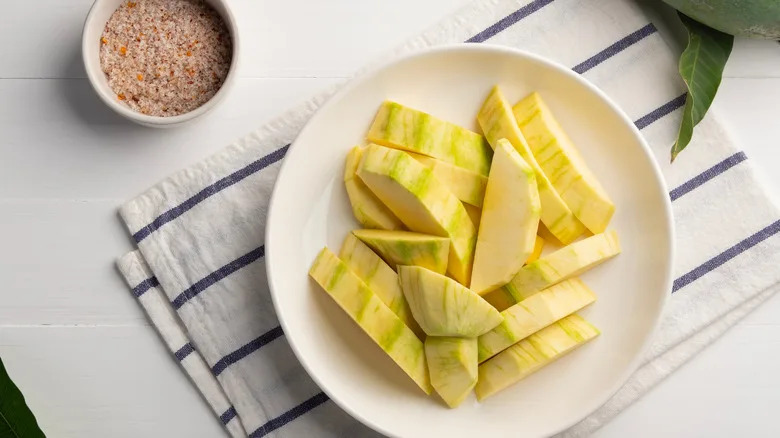
Raw green mango with chile salt – Kritchai7752/Shutterstock
“Fruit” encapsulates a very large umbrella of foods, many of which can be made tastier with the addition of salt. “For Filipinos, salting fruit is second nature,” says Audrey Santos, sous chef at Maricel’s Kitchen. She notes that everything from pineapple and watermelon to papaya is doused with salt. She gives the example of a tart green mango with fermented shrimp paste called bagoong. “The sour mango and salty, funky sweet bagoong hit the palate together, creating a burst of umami that is bold, playful, and unforgettable.”
Olivia Roszkowski broke down the science of why this fruit and salt combination is so popular. “This generally works because the sodium ions present in salt naturally suppress bitter notes in the fruit. Salt also draws moisture to the surface through osmosis, further concentrating the flavor,” she says. If you’re sprinkling salt on the fruit before serving, which you might for a slice of watermelon or tomato, Roszkowski recommends going for a fine salt, which will dissolve more quickly. She shares that you could even use a chili salt for your fruit: This would be excellent on mango or a mango-based dessert, like sorbet.
You can also think about pairing fruit with traditionally salty ingredients. Take inspiration from Salt & Straw’s mango prosciutto ice cream (and Roszkowski) and try eating your sweet melon with salty prosciutto. Roszkowski also suggests playing with salty fermented condiments, like miso, fish sauce, and soy sauce, or salty cheeses in a savory salad with fruit. “This is why watermelon with feta cheese and tomato matched with mozzarella are classic pairings,” she says.
Ice cream
Person sprinkling salt on chocolate ice cream – Kamile Kave/Shutterstock
Ice cream is known for being a sweet and refreshing treat best enjoyed on a hot summer day, and it turns out that it makes an excellent pairing for salty flavors as well. Like many of the sweet foods on this list, salt helps bring out the flavor of the ice cream. And although it might seem odd to sprinkle a little bit of sea salt on top of your next sundae, it’s not as odd when you start considering the number of salty ice cream add-ins, toppings, and sauces out there.
One salty, crunchy ice cream topping worth trying is potato chips. The salt intermingles with the ice cream, giving it a slightly savory bite that’s tempered by the creamy sweetness. Try it with a decadent chocolate or plain vanilla for maximum effect. You can also drizzle on a salted caramel sauce or grab a salty-leaning savory ice cream topping like bacon or pickles to accent your sundae. If you don’t want to alter the fundamental flavor of your ice cream though, a pinch of Maldon salt is going to be your best bet.
Cookies
Cookies with salty topping on a cooling rack – alexanderon/Shutterstock
We absolutely love playing with sweet and salty cookie recipes. While there’s nothing wrong with a basic chocolate chip or gingersnap cookie, something new is unlocked when you pair a classically sweet cookie with a salty, savory element. Not only does the salty component enhance the natural sweetness, but it also may draw your attention to other flavors that were otherwise eclipsed by that cloyingness — including heat, butteriness, and spice.
To get acclimated to playing with salty and sweet flavors, we recommend starting with a recipe that you love, like a classic chocolate chip, and finding just one way to add a salty component to it. You can try adding a sprinkle of sea salt right after the cookies exit the oven (ensuring the crystals adhere to the cookie) to get your bearings, then experiment from there. We love adding miso to our cookie batter because it adds a slightly savory edge and funk to the cookie, as well as a salty flavor that goes well with both the chocolate and the brown sugar base. You can also take more of a kitchen sink-approach to your cookies and stud them with potato chips, pretzels, or even salty popcorn to change their texture and flavor.
Peanut butter-based desserts
Peanut butter and salted caramel cupcakes – Larisa Sadomtseva/Shutterstock
Peanut butter and salt are ingredients that go hand-in-hand, which is why any peanut butter dessert that you’re making can always be improved with a little bit of salt. Think peanut butter pie, peanut butter cheesecake, and peanut butter frosting.
Before you add salt to your peanut butter-based desserts, you’ll want to get an idea of how salty your peanut butter is to begin with. Some peanut butter brands are already pre-salted, while others do not. Generally, if you’re baking, you’ll want to use non-salted ingredients (especially when it comes to butter) so you have more control over how salty something is. The salt will accentuate the naturally nutty flavor of the peanut butter and give your sweet treats a slightly more savory edge. You can also serve slices of peanut butter pie with a sprinkle of flaky sea salt or add a scoop of miso to your peanut butter cookie batter. Peanut butter ice cream could really benefit from the addition of salty pretzels, too. And if your recipe calls for whole peanuts, add roasted, salted peanuts for an extra dose of flavor.
Marshmallows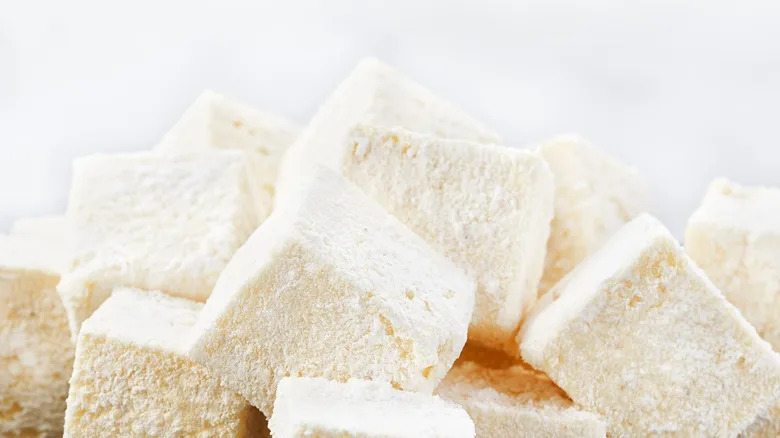
Stack of marshmallows on a white background – Mila Bond/Shutterstock
Making homemade marshmallows is nothing short of a labor of love. But doing it yourself will give you some more control over their flavor and allow you to add more flavors to them than you’d find in the s’mores section of the grocery store.
Normally, when you make homemade marshmallows, you combine very sweet sugar syrup with gelatin until it fluffs up like a meringue. After that, the trays can be set to cool. You can add a salty twist to your marshmallows, which will help balance the sweetness and draw more attention to other flavors like vanilla, by adding sea salt to the recipe when you’re making your sugar syrup. Alternatively, you can give your marshmallows a distinctly salty and toasty profile by swirling salted caramel into them. Once your marshmallow mixture is whipped, transfer some of it to a setting pan and drizzle in your salted caramel, swirling with a toothpick. Repeat this process until you have defined layers of caramel-swirled marshmallows.
Salt is also a good match for desserts containing marshmallows, including Rice Krispies treats and s’mores. Add a sprinkle of salt to your finished treats before eating, or find creative salty add-ins to incorporate. Swapping your graham crackers with salted peanut butter cookies or using a salted chocolate square rather than a plain chocolate one are options for s’mores, while adding a salted caramel drizzle to your Rice Krispies treats would give them a divine flavor.
Pudding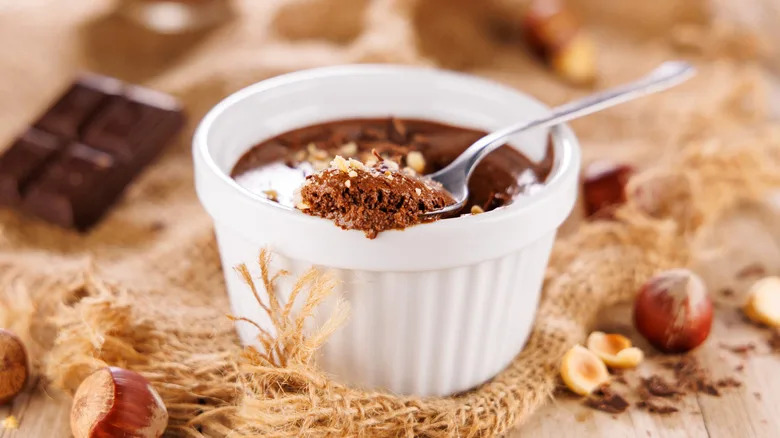
Chocolate pudding on a spoon with chopped and whole hazelnuts – Margouillatphotos/Getty Images
Puddings come in many forms, from the chocolate variety enjoyed in school cafeterias to the tapioca pudding that has been relegated to the confines of history. Traditionally, pudding is made of cream or dairy, and by adding a sprinkle of salt directly to that cream as it’s heating it will help balance the flavor. It’ll bring out the flavor of the chocolate in a chocolate pudding, and can help temper the sweetness of a caramel, butterscotch, or vanilla-based pudding as well.
Besides salting the pudding as it’s being prepared, you can also integrate its flavor with salty toppings. Try adding a pinch of salt to your whipped cream before drizzling it on top of your pudding, or add a sprinkle of salt to your bowl of pudding before serving it. If you’re taking the next step and layering it in a trifle, add salty ingredients to complement the sweet, milky pudding like, peanut butter cookies, salted nuts, or pretzels.
Fudge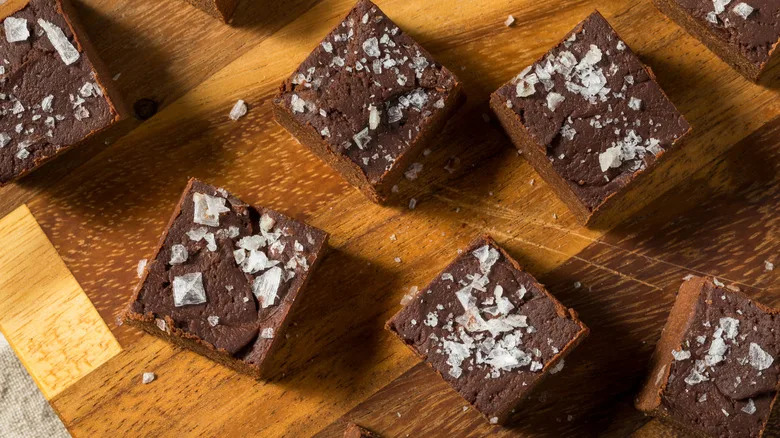
Chocolate fudge with salt flakes on a wooden platter – Brent Hofacker/Shutterstock
Fudge is a must-buy at any old country store. It’s decadent, sweet, and the perfect food to eat way too much of on the car ride home. While the flavors may vary, most fudge recipes are made by cooking sugar with butter, cream, and flavorings until it reaches the perfect consistency, then letting it set before cutting. Adding salt to your fudge recipe will make the sweetness pop and balance the richness of the butter and cream (or milk), and it doesn’t take much.
Salt works just as well in a traditional recipe as it does in a shortcut fudge recipe made with sweetened condensed milk and melted chocolate chips. After you’ve poured the fudge into a pan to set, you can also add a sprinkle of flaky sea salt on top so it’s the first thing your taste buds experience when you bite into the treat. If you prefer a saltier flavor all around, try your hand at peanut butter, salted caramel, maple sea salt, or pretzel fudge.
Want more food knowledge? Sign up to our free newsletter where we’re helping thousands of foodies, like you, become culinary masters, one email at a time.
Read the original article on Chowhound.


Dining and Cooking